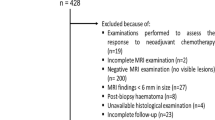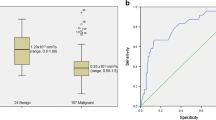Abstract
Objectives
To evaluate the value of adding T2- and diffusion-weighted imaging (DWI) to the BI-RADS® classification in MRI-detected lesions.
Methods
This retrospective study included 112 consecutive patients who underwent 3.0T structural breast MRI with T2- and DWI on the basis of EUSOMA recommendations. Morphological and kinetic features, T2 signal intensity (T2 SI) and apparent diffusion coefficient (ADC) findings were assessed.
Results
Thirty-three (29.5 %) patients (mean age 57.0 ± 12.7 years) had 36 primarily MRI-detected incidental lesions of which 16 (44.4 %) proved to be malignant. No single morphological or kinetic feature was associated with malignancy. Both low T2 SI (P = 0.009) and low ADC values (≤0.87 × 10−3 mm2s−1, P < 0.001) yielded high specificity (80.0 %/80.0 %). The BI-RADS classification supplemented with information from DWI and T2-WI improved the diagnostic performance of the BI-RADS classification as sensitivity remained 100 % and specificity improved from 30 % to 65.0 %. The numbers of false positive lesions declined from 39 % (N = 14) to 19 % (N = 7).
Conclusion
MRI-detected incidental lesions may be challenging to characterize as they have few specific malignancy indicating features. The specificity of MRI can be improved by incorporating T2 SI and ADC values into the BI-RADS assessment.
Key Points
• MRI-detected incidental lesions have few specific malignancy indicating features.
• ≥ 1 suspicious morphologic or kinetic feature may warrant biopsy.
• T2 signal intensity and DWI assessment are feasible in primarily MRI-detected lesions.
• T2 SI and DWI assessment improve the BI-RADS specificity in MRI-detected lesions.



Similar content being viewed by others
References
Teifke A, Lehr HA, Vomweg TW, Hlawatsch A, Thelen M (2003) Outcome analysis and rational management of enhancing lesions incidentally detected on contrast-enhanced MRI of the breast. AJR Am J Roentgenol 181:655–662
Brown J, Smith RC, Lee CH (2001) Incidental enhancing lesions found on MR imaging of the breast. AJR Am J Roentgenol 176:1249–1254
Peters NH, van Esser S, van den Bosch MA et al (2011) Preoperative MRI and surgical management in patients with nonpalpable breast cancer: the MONET—randomised controlled trial. Eur J Cancer 47:879–886
Gonzalez V, Sandelin K, Karlsson A, Åberg W, Löfgren L, Gabriela Iliescu G et al (2014) Preoperative MRI of the Breast (POMB) influences primary treatment in breast cancer: a prospective, randomized, multicenter study. World J Surg 38:1685–1693
Turnbull L, Brown S, Harvey I, Olivier C, Drew P, Napp V et al (2010) Comparative effectiveness of MRI in breast cancer (COMICE) trial: a randomised controlled trial. Lancet 375:563–571
Langer SA, Horst KC, Ikeda DM, Daniel BL, Kong CS, Dirbas FM (2005) Pathologic correlates of false positive breast magnetic resonance imaging findings: which lesions warrant biopsy? Am J Surg 190:633–640
Bluemke DA, Gatsonis CA, Chen MH, DeAngelis GA, DeBruhl N, Harms S et al (2004) Magnetic resonance imaging of the breast prior to biopsy. JAMA 292:2735–2742
Linda A, Zuiani C, Londero V, Bazzocchi M (2008) Outcome of initially only magnetic resonance mammography-detected findings with and without correlate at second-look sonography: distribution according to patient history of breast cancer and lesion size. Breast 17:51–57
LaTrenta LR, Menell JH, Morris EA, Abramson AF, Dershaw DD, Liberman L (2003) Breast lesions detected with MR imaging: utility and histopathologic importance of identification with US. Radiology 227:856–861
Morris EA, Comstock CE, Lee CH et al (2013) ACR BI-RADS® Magnetic Resonance Imaging. In: ACR BI-RADS® Atlas, Breast Imaging Reporting and Data System. Reston, VA, American College of Radiology
Orel SG, Schnall MD (2001) MR imaging of the breast for the detection, diagnosis, and staging of breast cancer. Radiology 220:13–30
Kuhl CK, Klaschik S, Mielcarek P, Gieseke J, Wardelmann E, Schild HH (1999) Do T2 weighted pulse sequences help with the differential diagnosis of enhancing lesions in dynamic breast MRI? J Magn Reson Imaging 9:187–196
Schnall MD, Blume J, Bluemke DA, DeAngelis GA, DeBruhl N, Harms S et al (2006) Diagnostic architectural and dynamic features at breast MR imaging: multicenter study. Radiology 238:42–53
Fischer U, Kopka L, Grabbe E (1999) Breast carcinoma: effect of preoperative contrast-enhanced MR imaging on the therapeutic approach. Radiology 213:881–888
Baum F, Fischer U, Vosshenrich R, Grabbe E (2002) Classification of hypervascularized lesions in CE MR imaging of the breast. Eur Radiol 12:1087–1092
Tozaki M, Igarashi T, Matsushima S, Fukuda K (2005) High-spatial-resolution MR imaging of focal breast masses: interpretation model based on kinetic and morphological parameters. Radiat Med 23:43–50
Ikeda DM, Hylton NM, Kinkel K, Hochman MG, Kuhl CK, Kaiser WA et al (2001) Development, standardization, and testing of a lexicon for reporting contrast-enhanced breast magnetic resonance imaging studies. J Magn Reson Imaging 13:889–895
Tilanus-Linthorst MM, Obdeijn IM, Bartels KC (2005) MARIBS study. Lancet 366:291–292
Baltzer PA, Dietzel M, Kaiser WA (2013) A simple and robust classification tree for differentiation between benign and malignant lesions in MR-mammography. Eur Radiol 23:2051–2060
Yamaguchi K, Schacht D, Sennett CA, Newstead GM, Imaizumi T, Irie H et al (2013) Decision making for breast lesions initially detected at contrast-enhanced breast MRI. AJR Am J Roentgenol 201:1376–1385
Zhu Y, Zhang S, Liu P, Hong L, Xu Y, Yang WT (2012) Solitary intraductal papillomas of the breast: MRI features and differentiation from small invasive ductal carcinomas. Am J Roentgenol 199:936–942
Partridge SC, Demartini WB, Kurland BF, Eby PR, White SW, Lehman CD (2010) Differential diagnosis of mammographically and clinically occult breast lesions on diffusion-weighted MRI. J Magn Reson Imaging 31:562–570
Parsian S, Rahbar H, Allison KH, Demartini WB, Olson ML, Lehman CD, Partridge SC Nonmalignant breast lesions: ADCs of benign and high-risk subtypes assessed as false-positive at dynamic enhanced MR imaging. 265(3):696–706. doi:10.1148/radiol.12112672
Arponen O, Sudah M, Masarwah A, Taina M, Rautiainen S, Könönen M et al (2015) Diffusion-weighted imaging in 3.0 Tesla breast MRI: diagnostic performance and tumor characterization using small subregions vs. whole tumor regions of interest. PLoS ONE 10:e0138702
Sardanelli F, Boetes C, Borisch B et al (2010) Magnetic resonance imaging of the breast: recommendations from the EUSOMA working group. Eur J Cancer 46:1296–1316
Rasband, WS. ImageJ, U. S. National Institutes of Health, Bethesda, Maryland, USA, http://imagej.nih.gov/ij/, 1997–2014
Lalkhen AG, McCluskey A (2008) Clinical tests: sensitivity and specificity. Contin Educ Anaesth Crit Care Pain 8:221–223
Ballesio L, Savelli S, Angeletti M, Porfiri LM, D’Ambrosio I, Maggi C et al (2009) Breast MRI: Are T2 IR sequences useful in the evaluation of breast lesions? Eur J Radiol 71:96–101
Yuen S, Uematsu T, Kasami M et al (2007) Breast carcinomas with strong high-signal intensity on T2-weighted MR images: pathological characteristics and differential diagnosis. J Magn Reson Imaging 25:502–510
El Khouli RH, Jacobs MA, Mezban SD, Huang P, Kamel IR, Macura KJ et al (2010) Diffusion-weighted imaging improves the diagnostic accuracy of conventional 3.0-T breast MR imaging. Radiology 256:64–73
Pinker K, Bickel H, Helbich TH, Gruber S, Dubsky P, Pluschnig U et al (2013) Combined contrast-enhanced magnetic resonance and diffusion-weighted imaging reading adapted to the “Breast Imaging Reporting and Data System” for multiparametric 3-T imaging of breast lesions. Eur Radiol 23:1791–1802
Baltzer PA, Dietzel M, Kaiser WA (2011) Nonmass lesions in magnetic resonance imaging of the breast: additional T2-weighted images improve diagnostic accuracy. J Comput Assist Tomogr 35:361–366
Abe H, Schmidt RA, Shah RN et al (2010) MR- directed (“Second-Look”) US examination for breast lesions detected initially on MRI: MR and sonographic findings. AJR Am J Roentgenol 194:370–377
Nunes LW, Schnall MD, Orel SG (2001) Update of breast MR imaging architectural interpretation model. Radiology 219:484–494
Mahoney MC, Gatsonis C, Hanna L, DeMartini WB, Lehman C (2012) Positive predictive value of BI-RADS MR imaging. Radiology 264:51–58
Partridge SC, Mullins CD, Kurland BF, Allain MD, DeMartini WB, Eby PR et al (2010) Apparent diffusion coefficient values for discriminating benign and malignant breast MRI lesions: effects of lesion type and size. AJR Am J Roentgenol 194:1664–1673
Spick C, Pinker-Domenig K, Rudas M, Helbich TH, Baltzer PA (2014) MRI-only lesions: application of diffusion- weighted imaging obviates unnecessary MR-guided breast biopsies. Eur Radiol 24:1204–1210
Yabuuchi H, Matsuo Y, Sunami S, Kamitani T, Kawanami S, Setoguchi T et al (2011) Detection of non-palpable breast cancer in asymptomatic women by using unenhanced diffusion-weighted and T2-weighted MR imaging: comparison with mammography and dynamic contrast-enhanced MR imaging. Eur Radiol 21:11–17
Baltzer PA, Benndorf M, Dietzel M, Gajda M, Camara O, Kaiser WA (2010) Sensitivity and specificity of unenhanced MR mammography (DWI combined with T2-weighted TSE imaging, ueMRM) for the differentiation of mass lesions. Eur Radiol 20:1101–1110
Debald M, Abramian A, Nemes L, Döbler M, Kaiser C, Keyver-Paik MD et al (2015) Who may benefit from preoperative breast MRI? A single-center analysis of 1102 consecutive patients with primary breast cancer. Breast Cancer Res Treat 1
Lim HI, Choi JH, Yang JH, Han BK, Lee JE, Lee SK et al (2010) Does pre-operative breast magnetic resonance imaging in addition to mammography and breast ultrasonography change the operative management of breast carcinoma? Breast Cancer Res Treat 119:163–167
Clauser P, Marcon M, Maieron M, Zuiani C, Bazzocchi M, Baltzer PA (2015) Is there a systematic bias of apparent diffusion coefficient (ADC) measurements of the breast if measured on different workstations? An inter- and intra-reader agreement study. Eur Radiol
Giannotti E, Waugh S, Priba L, Davis Z, Crowe E, Vinnicombe S (2015) Assessment and quantification of sources of variability in breast apparent diffusion coefficient (ADC) measurements at diffusion weighted imaging. Eur J Radiol 84:1729–1736
Chen X, Li WL, Zhang YL, Wu Q, Guo YM, Bai ZL (2010) Meta-analysis of quantitative diffusion-weighted MR imaging in the differential diagnosis of breast lesions. BMC Cancer 10:693
Belli G, Busoni S, Ciccarone A, Coniglio A, Esposito M et al (2015) Quality assurance multicenter comparison of different MR scanners for qualitative diffusion-weighted imaging. J Magn Reson Imaging 00:1–7
Acknowledgments
The scientific guarantor of this publication is Prof. Ritva Vanninen. The authors of this manuscript declare no relationships with any companies whose products or services may be related to the subject matter of the article. Otso Arponen received an EVO grant from Kuopio University Hospital (https://www.psshp.fi/) and a grant from the Cancer Society of Finland (http://www.cancer.fi/en/). The funders had no role in the study design, data collection and analysis, decision to publish or preparation of the manuscript. Tuomas Selander (Kuopio University Hospital) kindly provided statistical advice for this manuscript. Institutional review board approval was obtained. Written informed consent was waived by the chair of the hospital district for this study because of the clinical imaging protocols and retrospective nature of the analyses. Some study subjects or cohorts have been previously reported in the following paper: Arponen O, Sudah M, Masarwah A, Taina M, Rautiainen S, Könönen M, Sironen R, Kosma VM, Sutela A, Hakumäki J, Vanninen R. Diffusion-Weighted Imaging in 3.0 Tesla Breast MRI: Diagnostic Performance and Tumor Characterization Using Small Subregions vs. Whole Tumor Regions of Interest. Plos One. DOI: 10.1371/journal.pone.0138702. Methodology: retrospective, diagnostic or prognostic study, performed at one institution.
Author information
Authors and Affiliations
Corresponding author
Rights and permissions
About this article
Cite this article
Arponen, O., Masarwah, A., Sutela, A. et al. Incidentally detected enhancing lesions found in breast MRI: analysis of apparent diffusion coefficient and T2 signal intensity significantly improves specificity. Eur Radiol 26, 4361–4370 (2016). https://doi.org/10.1007/s00330-016-4326-2
Received:
Revised:
Accepted:
Published:
Issue Date:
DOI: https://doi.org/10.1007/s00330-016-4326-2




